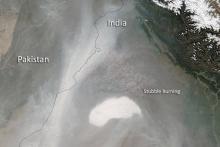To clear the way for planting wheat in November, a farmer in Punjab, India, sets aflame the leftover straw, or stubble, of a harvested rice paddy crop in October. The burning residue fills the air with carbon monoxide, ozone, and fine particulate matter (PM2.5) that will make it harder to breathe for days afterward and for miles around. It’s a scene that’s replicated on about 2 million farms in the Punjab and Haryana states of northwest India every autumn (and every spring after the wheat harvest), raising health risks — particularly of respiratory and cardiovascular diseases — and premature death rates downwind in India and throughout South Asia.
To date, government regulations, largely imposed at the state and national level, have been ineffective in curtailing crop residue burning in India. The practice continues apace, driven by the limited economic value of rice and wheat residues, and the ongoing need for cheap, ultrafast disposal of residues between harvesting and planting of the rotating crops. Such attempted bans are also deeply unpopular. A national ban on burning was repealed last year due to pressure from farmers, who see such legislation as further increasing the already-significant economic hardships faced by small-scale landowners.



